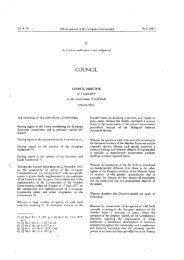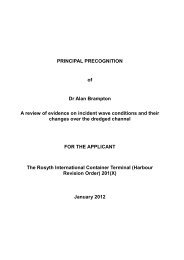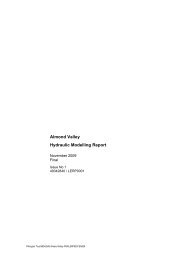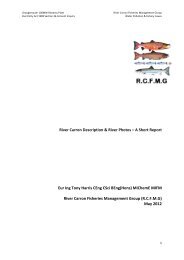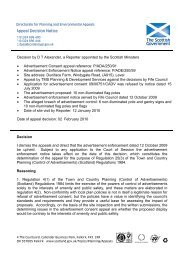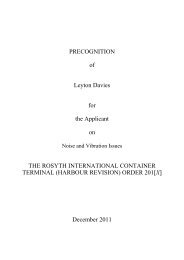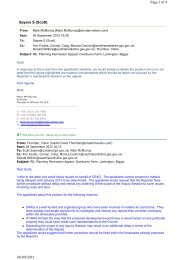Landscape architecture - Directorate for Planning and ...
Landscape architecture - Directorate for Planning and ...
Landscape architecture - Directorate for Planning and ...
You also want an ePaper? Increase the reach of your titles
YUMPU automatically turns print PDFs into web optimized ePapers that Google loves.
Position statement<br />
Page 3<br />
1.6 These competing dem<strong>and</strong>s require new <strong>and</strong> regenerated l<strong>and</strong>scapes, in the UK <strong>and</strong><br />
across the world, to be planned, designed <strong>and</strong> managed in a far more sustainable way<br />
than is currently practised. This needs to be based on a thorough underst<strong>and</strong>ing of<br />
ecosystem services <strong>and</strong> the interconnectivity of natural processes <strong>and</strong> human life.<br />
1.7 Climate change will have profound effects upon every aspect of our society, our<br />
economy <strong>and</strong> the ecosystems which support them. All of these present risks<br />
<strong>for</strong> l<strong>and</strong>scape in its broadest sense <strong>and</strong> are of direct concern to the work of the<br />
l<strong>and</strong>scape architect. Through their training <strong>and</strong> expertise, l<strong>and</strong>scape architects are<br />
well positioned to provide holistic approaches to the planning <strong>and</strong> management<br />
of the built environment <strong>and</strong> rural areas. They have the ability to help address the<br />
environmental, social <strong>and</strong> economic challenges which face us all.<br />
1.8 Recognition of this fact presents an opportunity <strong>for</strong> l<strong>and</strong>scape architects to shape<br />
a renaissance in the quality of both natural <strong>and</strong> built environments, ensuring a<br />
sustainable future not only <strong>for</strong> people <strong>and</strong> places but also <strong>for</strong> flora <strong>and</strong> fauna.<br />
2. Responding to climate change 2.1 <strong>L<strong>and</strong>scape</strong>s that are multifunctional have the ability to provide food, energy, water<br />
storage <strong>and</strong> flood mitigation as well as providing a valuable resource <strong>for</strong> biodiversity<br />
<strong>and</strong> promoting health <strong>and</strong> well being. The holistic approach traditionally taken by the<br />
l<strong>and</strong>scape architect to masterplanning, l<strong>and</strong>scape design <strong>and</strong> management means<br />
that the profession has a responsibility <strong>for</strong> environmental stewardship. The profession<br />
also has a wider role to plan, create <strong>and</strong> design sustainable communities, bringing a<br />
balanced environmental, social <strong>and</strong> economic approach to tackling climate change.<br />
2.2 Sustainable l<strong>and</strong>scape planning, design <strong>and</strong> management are essential if we are to<br />
adapt our environments to a changing climate <strong>and</strong> to mitigate future change. In many<br />
instances, l<strong>and</strong>scape responses incorporate a range of mitigation <strong>and</strong> adaptation<br />
principles, with many of these being interlinked <strong>and</strong> mutually-rein<strong>for</strong>cing, whilst also<br />
providing wider socio-economic <strong>and</strong> environmental benefits. For example, provision<br />
of urban green space will mitigate through carbon storage as well as reducing surface<br />
run-off, an important aspect of adaptation.<br />
2.3 <strong>L<strong>and</strong>scape</strong> architects provide an holistic approach to the protection, conservation <strong>and</strong><br />
enhancement of urban <strong>and</strong> rural l<strong>and</strong>scapes which takes account of environmental,<br />
social <strong>and</strong> economic conditions. This approach will assist in mitigating <strong>and</strong> adapting<br />
to future climate change <strong>and</strong> ensure the future sustainability of our l<strong>and</strong>scapes <strong>and</strong><br />
the communities within them.<br />
3. Mitigation 3.1 There is a growing consensus that human activities are at least making a contribution<br />
to climate change via greenhouse gas emissions. This means that all of us can take<br />
steps to lessen the magnitude of future change. The <strong>L<strong>and</strong>scape</strong> Institute recognises<br />
fully the need to reduce human-induced causes of climate change. There are many<br />
ways, at a range of different scales, in which l<strong>and</strong>scape architects can play a central<br />
role in helping to achieve this.<br />
3.2 Large scale intervention<br />
— In functioning as masterplanners, l<strong>and</strong>scape architects can shape all facets of<br />
existing <strong>and</strong> new communities to encourage more sustainable lifestyles.<br />
— Fully integrating building <strong>and</strong> site planning into the l<strong>and</strong>scape planning process,<br />
taking account of l<strong>and</strong>scape characteristics such as topography, vegetation <strong>and</strong><br />
microclimate <strong>and</strong> helping to maximise the benefits of shelter from intense wind<br />
<strong>and</strong> sun while seeking to incorporate maximum solar energy <strong>and</strong> water heating<br />
benefits.<br />
— Providing attractive opportunities <strong>for</strong> local outdoor leisure opportunities, also<br />
contributing to improving public health, well being <strong>and</strong> community engagement.<br />
— Integrating <strong>and</strong> maximising local food production in the l<strong>and</strong>scape, thereby<br />
reducing ‘food miles’ as a result of transportation <strong>and</strong> promoting more localised<br />
self-sufficiency.<br />
<strong>L<strong>and</strong>scape</strong> Institute<br />
<strong>L<strong>and</strong>scape</strong> <strong>architecture</strong> <strong>and</strong> the challenge of climate change



